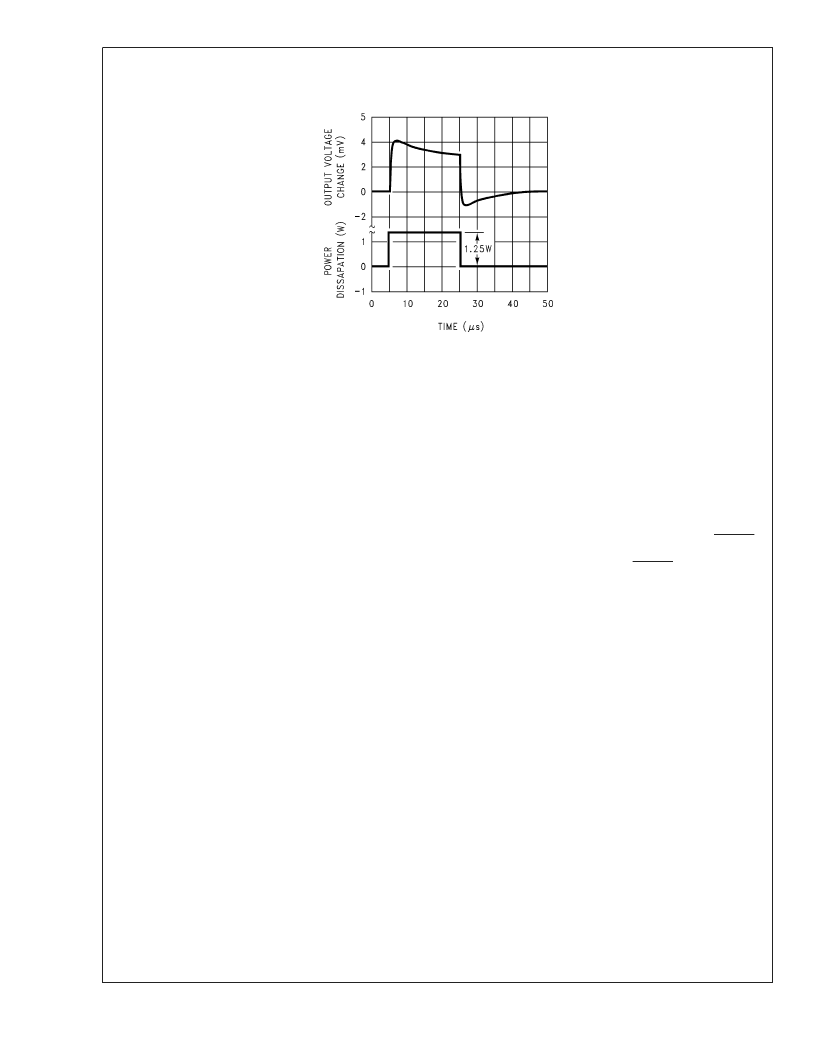- 您現(xiàn)在的位置:買賣IC網(wǎng) > PDF目錄358930 > LP4951 (National Semiconductor Corporation) Adjustable Micropower Voltage Regulators PDF資料下載
參數(shù)資料
| 型號: | LP4951 |
| 廠商: | National Semiconductor Corporation |
| 英文描述: | Adjustable Micropower Voltage Regulators |
| 中文描述: | 可調(diào)微功耗電壓調(diào)節(jié)器 |
| 文件頁數(shù): | 10/14頁 |
| 文件大小: | 436K |
| 代理商: | LP4951 |

Typical Performance Characteristics
(Continued)
Thermal Response
20052858
Application Hints
EXTERNAL CAPACITORS
A 1.0μF (or greater) capacitor is required between the output
and ground for stability at output voltages of 5V or more. At
lower output voltages, more capacitance is required. Without
this capacitor the part will oscillate. Most types of tantalum or
aluminum electrolytics work fine here; even film types work
but are not recommended for reasons of cost. Many alumi-
num electrolytics have electrolytes that freeze at about
30C, so solid tantalums are recommended for operation
below 25C. The important parameters of the capacitor are
an ESR of about 5
or less and a resonant frequency above
500 kHz. The value of this capacitor may be increased
without limit.
At lower values of output current, less output capacitance is
required for stability. The capacitor can be reduced to
0.33 μF for currents below 10 mA or 0.1 μF for currents
below 1 mA. Using the 8-pin version at voltages below 5V
runs the error amplifier at lower gains so that
more
output
capacitance is needed. For the worst-case situation of a
100 mA load at 1.23V output (Output shorted to Feedback) a
3.3 μF (or greater) capacitor should be used.
Unlike many other regulators, the LP4950C will remain
stable and in regulation with no load in addition to the
internal voltage divider. This is especially important in CMOS
RAM keep-alive applications. When setting the output volt-
age of the LP4951C version with external resistors, a mini-
mum load of 1μA is recommended.
A 0.1μF capacitor should be placed from the LP4950C/
LP4951C input to ground if there is more than 10 inches of
wire between the input and the AC filter capacitor or if a
battery is used as the input.
Stray capacitance to the LP4951C Feedback terminal (pin 7)
can cause instability. This may especially be a problem when
using high value external resistors to set the output voltage.
Adding a 100pF capacitor between Output and Feedback
and increasing the output capacitor to at least 3.3μF will fix
this problem.
ERROR DETECTION COMPARATOR OUTPUT
The comparator produces a logic low output whenever the
LP4951C output falls out of regulation by more than approxi-
mately 5%. This figure is the comparator’s built-in offset of
about 60 mV divided by the 1.235 reference voltage. (Refer
to the block diagram in the front of the datasheet.) This trip
level remains “5% below normal” regardless of the pro-
grammed output voltage of the 4951C. For example, the
error flag trip level is typically 4.75V for a 5V output or 11.4V
for a 12V output. The out of regulation condition may be due
either to low input voltage, current limiting, or thermal limit-
ing.
Figure 1
below gives a timing diagram depicting the ERROR
signal and the regulated output voltage as the LP4951C
input is ramped up and down. The ERROR signal becomes
valid (low) at about 1.3V input. It goes high at about 5V input
(the input voltage at which V
= 4.75V). Since the
LP4951C’s dropout voltage is load-dependent (see curve in
typical performance characteristics), the
input
voltage trip
point (about 5V) will vary with the load current. The
output
voltage trip point (approx. 4.75V) does not vary with load.
The error comparator has an open-collector output which
requires an external pullup resistor. This resistor may be
returned to the output or some other supply voltage depend-
ing on system requirements. In determining a value for this
resistor, note that while the output is rated to sink 400μA, this
sink current adds to battery drain in a low battery condition.
Suggested values range from 100k to 1 M
. The resistor is
not required if this output is unused.
L
www.national.com
10
相關(guān)PDF資料 |
PDF描述 |
|---|---|
| LP4951CM | Adjustable Micropower Voltage Regulators |
| LP508 | Class A Amplifier with 2 Independent Gain Blocks |
| LP508SLT | Analog IC |
| LP508PLID | Analog IC |
| LP508MINI | Analog IC |
相關(guān)代理商/技術(shù)參數(shù) |
參數(shù)描述 |
|---|---|
| LP4951C | 制造商:NSC 制造商全稱:National Semiconductor 功能描述:Adjustable Micropower Voltage Regulators |
| LP4951CM | 功能描述:低壓差穩(wěn)壓器 - LDO RoHS:否 制造商:Texas Instruments 最大輸入電壓:36 V 輸出電壓:1.4 V to 20.5 V 回動電壓(最大值):307 mV 輸出電流:1 A 負載調(diào)節(jié):0.3 % 輸出端數(shù)量: 輸出類型:Fixed 最大工作溫度:+ 125 C 安裝風格:SMD/SMT 封裝 / 箱體:VQFN-20 |
| LP4951CM/NOPB | 功能描述:低壓差穩(wěn)壓器 - LDO RoHS:否 制造商:Texas Instruments 最大輸入電壓:36 V 輸出電壓:1.4 V to 20.5 V 回動電壓(最大值):307 mV 輸出電流:1 A 負載調(diào)節(jié):0.3 % 輸出端數(shù)量: 輸出類型:Fixed 最大工作溫度:+ 125 C 安裝風格:SMD/SMT 封裝 / 箱體:VQFN-20 |
| LP4951CMX | 功能描述:低壓差穩(wěn)壓器 - LDO RoHS:否 制造商:Texas Instruments 最大輸入電壓:36 V 輸出電壓:1.4 V to 20.5 V 回動電壓(最大值):307 mV 輸出電流:1 A 負載調(diào)節(jié):0.3 % 輸出端數(shù)量: 輸出類型:Fixed 最大工作溫度:+ 125 C 安裝風格:SMD/SMT 封裝 / 箱體:VQFN-20 |
| LP4951CMX/HAPB | 制造商:Texas Instruments 功能描述: |
發(fā)布緊急采購,3分鐘左右您將得到回復。